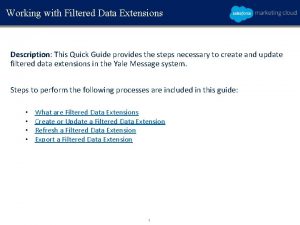Working with Filtered Data Extensions Description This Quick






- Slides: 6

Working with Filtered Data Extensions Description: This Quick Guide provides the steps necessary to create and update filtered data extensions in the Yale Message system. Steps to perform the following processes are included in this guide: • • What are Filtered Data Extensions Create or Update a Filtered Data Extension Refresh a Filtered Data Extension Export a Filtered Data Extension 1

What are Filtered Data Extensions (FDE) allow you to create new list from an existing list that contains a subset of the data in the original list. This replaces the Message III functionality of using a dropdown list to select a subset of an existing list. For example, students by class year, or faculty by department. To create an FDE, examine the data fields in the original Source file that you will use to create the FDE. You can view them from within Yale Message or export them to a CSV file. Field names and data values for similar fields will change depending on whether your data contains faculty, staff or students. Example: Faculty – Department Field Name Account_Name Staff – Department Data Value Neurosurgery Field Name Department– Students Data Value MEDNSG Neurosurgery School Field Name Account_Name Data Value Medical School 2 Back to Home

Create or Update a Filtered Data Extension Example Filtered Data Extensions (FDE) have been set up for you to use a starting point, and you can edit them for your current requirements. These FDE’s are located under: Salesforce Data Extensions -> Filtered Data Extensions Example: Faculty - by Department FDE This FDE is available to update the department that you wish to send to. 1. Click on the FDE to open it. 2. In the second section on the left, you will see the definition of the FDE. Click Edit to update it. 3. Click to the left of the field name to edit and enter the name of a different department. 4. After you enter the desired department, select Save and Refresh. This list is now ready for you to use. Faculty – by Department FDE now represents the department that you have changed it to. 3 Back to Home

Refresh a Filtered Data Extension It’s important to note that filtered data extensions will not auto-update. If you need to use it again for the same department, you will need to refresh it. To do so, click the refresh button to the right of the FDE as shown below. If this FDE is used frequently, you can send a request to message. support@yale. edu to request it to auto-update. 4 Back to Home

Export Data Extensions As noted earlier, data values for similar fields will change depending on your selection of students, staff or faculty. For example, the department of Chemistry is defined as “Chemistry” for Faculty, whereas it is defined as “FASCHM Chemistry” for Staff. In order for the filters to work you must use the exact definition. If you need to see the data fields that you need to use for filtering, you can view the data from the source file. Click on your Source file to open it and then click the Records tab. This will display the first 200 records in the Source file and you should be able to see the field names and values from this view. You can copy the data value that you need to create your new filter. If you need to see all of the data, you can export it: Select Export. 5 Back to Home

Export Data Extensions (Cont. ) Select Browser Download This will download the contents of the data extension to your computer’s Downloads folder as a CSV file. Right-click on the filename and select Open with MS Excel. 6 Back to Home











